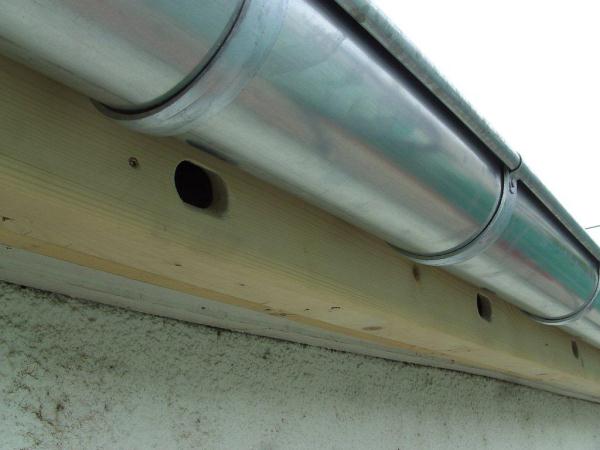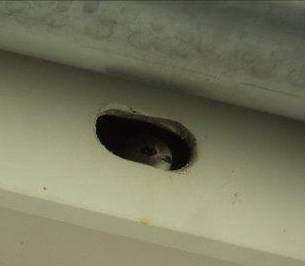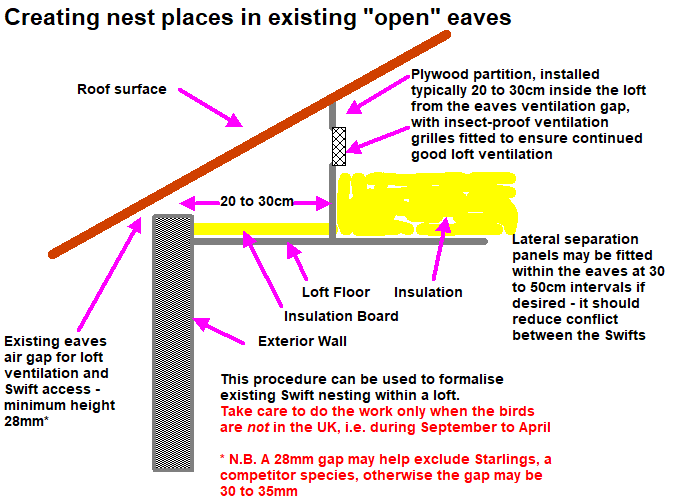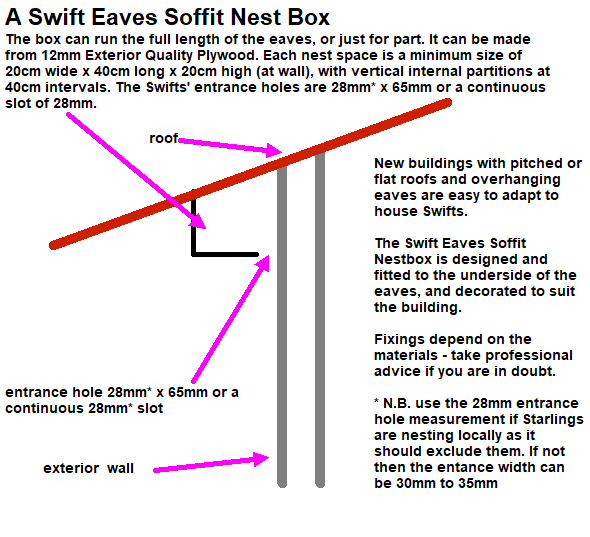 
This
eaves nest box, a multiple version offering many nest
places, was recently set up in Frankfurt, in Germany,
and as you can see, has already been successful
in attracting Swifts to breed. Photos
© Ingolf Grabow FMI 2010
 Suggestions for simple conversion and adaptation of eaves and lofts spaces to house Swifts cleanly and without fuss. By
using the principles and
dimensions of the designs below, existing eaves nest spaces can be saved, and
new ones created. Suggestions for simple conversion and adaptation of eaves and lofts spaces to house Swifts cleanly and without fuss. By
using the principles and
dimensions of the designs below, existing eaves nest spaces can be saved, and
new ones created.
 Ideally, all nest-places should be out of direct sunlight. Where
nest-places within direct sunlight are being replaced, care should be
taken to respect the original dimensions, as these (for example the
depth inside the eaves) may have kept the site cool enough to permit
successful breeding.
Ideally, all nest-places should be out of direct sunlight. Where
nest-places within direct sunlight are being replaced, care should be
taken to respect the original dimensions, as these (for example the
depth inside the eaves) may have kept the site cool enough to permit
successful breeding.
 Minimum nest place dimensions are 30cm wide by 40cm long by 15 to 20cm
high. A sloping roof of lesser height is acceptable as long as there is
adequate space further back for the Swifts to be able to flap their
wings. The entrance hole can be any size from 30mm to 50mm round, or
oval ( in which case 30mm high x 65mm wide, dimensions which should
exclude Starlings), in either the base or front of the nest space.
Minimum nest place dimensions are 30cm wide by 40cm long by 15 to 20cm
high. A sloping roof of lesser height is acceptable as long as there is
adequate space further back for the Swifts to be able to flap their
wings. The entrance hole can be any size from 30mm to 50mm round, or
oval ( in which case 30mm high x 65mm wide, dimensions which should
exclude Starlings), in either the base or front of the nest space.
 N.B. The loft area's ventilation and insulation should if necessary be
examined and assured by experts before starting work. Ventilation can
benefits Swifts, who often suffer from overheated nest places, but
early in the season they can also suffer from cold. These facts need to
be taken into account when converting eaves for Swifts.
N.B. The loft area's ventilation and insulation should if necessary be
examined and assured by experts before starting work. Ventilation can
benefits Swifts, who often suffer from overheated nest places, but
early in the season they can also suffer from cold. These facts need to
be taken into account when converting eaves for Swifts.
Swift nest places in existing "open" eaves
Boxing in the loft
space adjacent to the eaves to create a nest space just within the loft
replicates the existing nesting spaces used by the Swifts, but
formalises them, making them safer from intrusion and predation. It
limits the birds' access to only a small part of the loft interior,
while maintaining the loft ventilation inherent in the original design.
Insulation values can be improved by installing rigid insulation board
in the Swifts nesting space, while using fibre glass insulation outside
their nest areas, as shown below. It is vital that the Swifts do not
come into contact with any form of loose fibre or particulate
insulation material as this is know to injure them and may prove fatal.

Designing-in Swift nest places in new eaves
This solution uses
exterior quality plywood or planks to box in the eaves, providing a
base floor and internal partitions, with entrance holes drilled in the
underside or front face to give access to each nest-space. It can be
easily adapted to suit a very wide range of pitched and flat-roofed
buildings, provided they have overhanging eaves and these are 5 metres
or more above ground. Basic instructions are below, and photographs are
at the top of the page.

 Back to Fitting Swift Nest Places
Back to Fitting Swift Nest Places
 Back to Contents Back to Contents
|
 Nest Places in Eaves
Nest Places in Eaves




